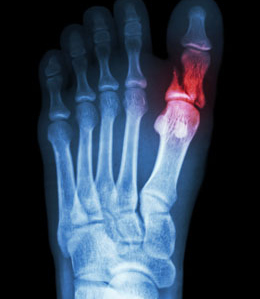This article is aimed at providing information on comminuted toe fracture, the causes, and the treatment options.

A comminuted toe fracture can cause severe complications, such as permanent deformation in the framework of toe bone, resulting in difficulty in movement, chronic pain, and in severe case, arthritis. The human toe is made up of bones, also termed as phalanges. The big toe consists of proximal phalanges at its bottom, and distal phalanges at the tip; while the other 4 consist of middle phalanges connecting distal phalanges and proximal phalanges.
Types
There are different types of bone fractures such as, comminuted, non displaced, compressed, and displaced fracture. Comminuted is the one which causes the bone to splinter into small fragments. The non displaced one causes the bone to break, however, it doesn't get displaced from its original position. The compressed type would cause the bone ends to get compressed towards the center. The last one, the displaced type changes the normal position of the bone. A compound fracture would cause laceration of soft tissue and the bone would bulge out from skin. This kind of injury is usually caused in the proximity of the metatarsophalangeal joint, which is where the toe is joined to metatarsals, or mid foot bones.
Causes and Symptoms
If a heavy load falls on your foot crushing your toes, or you strike your foot accidentally on an object while walking, or sometimes due to a severe accident, it may result in the injury in question. If the injury is severe, causing fragmentation of the bone, it leads to such a fracture. The location of the toes make them more prone to injury of foot. Certain sports require continuous and repetitive movements of the foot making them more susceptible. It is also referred to as stress fracture. Symptoms include inflammation and discomfort, along with stiffness. The person finds it difficult and painful to walk, since the big toe sustains more body weight while walking as compared to the others. A bruise may also be noticed around the injured area. If untreated, it can get permanently disfigured.
Diagnosis Methods
The diagnosis can be made by applying pressure on the affected area to check if you experience any pain or discomfort. Another test includes keeping your foot stationary and moving the toes in different directions. If you have a fracture, you will experience acute pain. And the doctor can observe restricted motion of the injured toe, as compared to the other ones. Another test involves squeezing the toe tip. The physician looks for the time required for the tip to return to normal color due to blood filling back in tip. This is done to determine if you have blood circulation problems. If the deformation is visible, tests like X-ray are done in order to determine the severity of fracture. X-ray reveals any deformation or internal injury such as crushing of the bones.
Treatment
Treatment depends upon the severity of the injury. If the fracture is unstable, which means, your toe can't hold its normal position, the doctor may heal it with the process called internal fixation. It is defined as the surgical procedure in which an incision is made to join the bones and hold them together by metal rods, plates, or wires. Depending on the severity, the injured toe needs to be splinted, in order to immobilize the fractured bone. In case of open wound, it becomes necessary to administer tetanus shot and antibiotics medication. In case of a compound fracture, surgery needs to be done and antibiotics, along with pain killers are prescribed. In case of a displacement fracture, where the broken bone gets displaced from the original position, closed reduction method can be used, wherein, the broken toe is taped with the next toe, to hold it onto the position. In this case, surgery is not required.
In case of any injury, seeking timely medical advise is the key to keep further complications at bay.
Disclaimer:
This Buzzle article is for informative purposes only, and should not be used as a replacement for expert medical advice.


 A comminuted toe fracture can cause severe complications, such as permanent deformation in the framework of toe bone, resulting in difficulty in movement, chronic pain, and in severe case, arthritis. The human toe is made up of bones, also termed as phalanges. The big toe consists of proximal phalanges at its bottom, and distal phalanges at the tip; while the other 4 consist of middle phalanges connecting distal phalanges and proximal phalanges.
A comminuted toe fracture can cause severe complications, such as permanent deformation in the framework of toe bone, resulting in difficulty in movement, chronic pain, and in severe case, arthritis. The human toe is made up of bones, also termed as phalanges. The big toe consists of proximal phalanges at its bottom, and distal phalanges at the tip; while the other 4 consist of middle phalanges connecting distal phalanges and proximal phalanges.